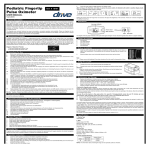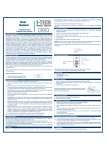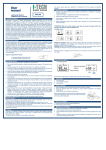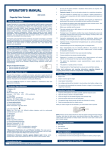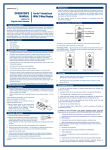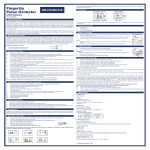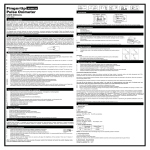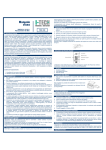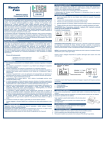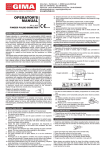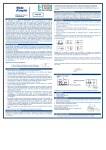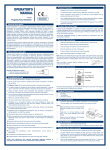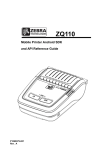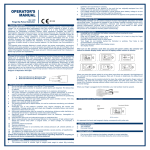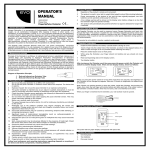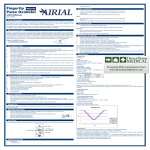Download OPERATOR`S MANUAL
Transcript
Product Operation Scope OPERATOR’S MANUAL V2.0C63 Fingertip Pulse Oximeter Fingertip PULSE OXIMETER is a portable non-invasive, spot-check, oxygen saturation of arterial hemoglobin (SpO2) and pulse rate of adult and pediatric patient at home, and hospital (including clinical use in internist/surgery, Anesthesia, intensive care monitoring etc). It's not for continuously monitoring. MD300C63 The PULSE OXIMETER requires no routine calibration or maintenance other than replacement of batteries. Operation Instructions General Description Oxygen Saturation is a percentage of Oxyhemoglobin (HbO2) capacity, compounded with oxygen, by all combinative hemoglobin (Hb) capacity in blood. In other words, it is consistency of Oxyhemoglobin in blood. It is a very important parameter for the Respiratory Circulation System. Many respiratory diseases can result in oxygen saturation being lowered in human blood. Additionally, the following factors can reduce oxygen saturation: Automatic regulation of organ dysfunction caused by Anesthesia, Intensive Postoperative Trauma, injuries caused by some medical examinations. That situation might result in light-headedness, asthenia, and vomiting. Therefore, it is very important to know the oxygen saturation of a patient so that doctors can find problems in a timely manner. 1. Installing two AAA batteries correctly. 2. Nip the clamp as diagram. 3. Insert one finger into rubber hole of the Oximeter fully. 4. Press the switch button once on front panel. 5. Your finger and body do not tremble during measuring. 6. Read corresponding data from display screen. 7. Six display modes After turning on the Oximeter, each time you press the power switch, the Oximeter will switch to another display mode. There are 6 display modes shown as follows: The fingertip pulse Oximeter features small size, low power consumption, convenient operation and portability. It is only necessary for a patient to put one of his fingers into the fingertip photoelectric sensor for diagnosis, and a display screen will show oxygen saturation. It has been proven in clinical experiments that it also features high precision and repeatability. Measurement principle Principle of the Oximeter is as follows: A mathematical formula is established making use of Lambert Beer Law according to Spectrum Absorption Characteristics of Reductive hemoglobin(RHb) and Oxyhemoglobin (HbO2) in glow and near-infrared zones. Operation principle of the instrument: Photoelectric Oxyhemoglobin Inspection Technology is adopted in accordance with Capacity Pulse Scanning and Recording Technology, so that two beams of different wavelength of lights (660nm glow and 940nm near infrared light) can be focused onto a human nail tip through a clamping finger-type sensor. A measured signal obtained by a photosensitive element, will be shown on the Oximeter’s display through process in electronic circuits and microprocessor shown on the Oximeter’s display through electronic circuits and a microprocessor. Diagram of Operation Principle 1. Red and Infrared-ray Emission Tube 2. Red and Infrared-ray Receipt Tube 1 2 3 4 5 6 When you press the power switch for a long time (more than one second), the brightness of the Oximeter will be changed by degrees, there are 10 levels on brightness; the default is level four. NOTE: Please use the medical alcohol to clean the rubber touching the finger inside of Oximeter, and clean the test finger using alcohol before and after each use. (The rubber inside of the Oximeter belongs to medical rubber, which has no toxin and no harm to the skin of human being). When your finger is plugged into the Oximeter, your nail surface must be upward. Precautions for use 1. Do not use the pulse oximeter in an MRI or CT environment 2. Do not use the pulse oximeter in situations where alarms are required. 3. Explosion hazard: Do not use the pulse oximeter in an explosive atmosphere. 4. The pulse oximeter is intended only as an adjunct in patient assessment. It must be used in conjunction with other methods of assessing clinical signs and symptoms. 5. Check the pulse oximeter sensor application site frequently to determine the positioning of the sensor and circulation and skin sensitivity of the patient. Brief Description of Front Panel Low power indicator 6. Do not stretch the adhesive tape while applying the pulse oximeter sensor. This may cause inaccurate readings or skin blisters. PR Bar graph 7. Before use, carefully read the manual. 8. The pulse oximeter has no SpO2 alarms; it is not for continuous monitoring, as indicated by the symbol. 9. Prolonged use or the patient’s condition may require changing the sensor site periodically. Change sensor site and check skin integrity, circulatory status, and correct alignment at least every 4 hours. 10. Inaccurate measurements may be caused by autoclaving, ethylene oxide sterilizing, or immersing the sensors in liquid may cause inaccurate readings. 11. Significant levels of dysfunctional hemoglobins (such as carbonxy- hemoglobin or methemoglobin) 12. Intravascular dyes such as indocyanine green or methylene blue 13. SpO2 measurements may be adversely affected in the presence of high ambient light. Shield the sensor area (with a surgical towel, or direct sunlight, for example) if necessary. 14. Excessive patient movement 15. Venous pulsations 16. Placement of a sensor on an extremity with a blood pressure cuff, arterial catheter, or intravascular line. 17. The patient has hypotension, severe vasoconstriction, severe anemia, or hypothermia SpO2 waveform SpO2 Product Accessories 1. One lanyard 2. Two batteries 3. One user manual Battery Installation 1. Put the two AAA batteries into battery cassette with correct polarities. 2. Press the button down on the rear panel and push the battery cover horizontally along the arrow shown as below: Press the button down! 18. The patient is in cardiac arrest or is in shock. 19. Fingernail polish or false fingernails may cause inaccurate SpO2 readings. Follow local ordinances and recycling instructions regarding disposal or recycling of the device and device components, including batteries. Product Properties 1. Operation of the product is simple and convenient. 2. The product is small in volume, light in weight and convenient in carrying. 3. Power consumption of the product is low. 4. Low voltage warning will be indicated in visual window when battery voltage is so low that normal operation of the Oximeter might be influenced. 5. The product will automatically be powered off when no signal is in the product for longer than 8 seconds. Pulse Rate The PR Bar graph displays corresponding with the patient’s pulse beat. The height of the bar graph shows the patient’s pulse strength. Notes: • Battery polarities must be correctly installed. Otherwise, damage might be caused to device. • Please put or remove batteries in right order, or is likely to damage the device bracket. • Please remove batteries if the Oximeter will not be used for a long time. Lanyard Installation 1. Thread thinner end of the hang lace through the hanging hole. 2. Thread thicker end of the lace through the threaded end before pulling it tightly. Maintenance and Storage Possible Problems and resolutions 1. Replace the batteries in time when low voltage lamp is lighted. 2. Clean surface of the fingertip Oximeter before it is used in diagnosis for patients. 3. Remove batteries inside the battery cassette if the Oximeter will not be operated for a long time. 4. It is best to preserve the product in a place where ambient temperature –20°C~55°C and humidity is <93% (no condensation). 5. It is recommended that the product should be kept in a dry environment anytime. A wet ambient might affect its lifetime and even might damage the product. 6. Please follow the law of the local government to deal with used batteries. Calibration 1. The functional tester cannot be used to assess the accuracy of the Oximeter. 2. Index 2 that made by Bioteck company is a function tester. Set Tech to 1, R curve to 2, and then a user can use this particular calibration curve to measure the Oximeter. 3. The test methods used to establish the SpO2 accuracy is clinical testing. The Oximeter used to measure the arterial haemoglobin oxygen saturation levels and these levels are to be compared to the levels determined from arterial blood sampling with a CO-Oximeter. Declaration EMC of this product complies with IEC60601-1-2 standard. The materials which the user can come into contact have no toxicity and no action on tissues, comply with ISO10993-1, ISO10993-5 and ISO10993-10. Detailed descriptions of product functions 1. Display Type: OLED display 2. SpO2: Measurement range: 70-100% Accuracy: 70%-100%, ±3%; ≤69% no definition. 3. Pulse Rate: Measure range: 30~235 BPM Accuracy: 30~99bpm ±2bpm; 100~235bpm, ±2%. Pulse Intensity: Bar graph Indicator 4. Power Requirements: Two AAA alkaline Batteries Power consumption: Less than 30mA Low power indication: Battery Life: Two AAA 1.5V, 800mAh alkaline batteries could be continuously operated as long as 30 hours. 5. Dimension: Length: 58mm Width: 32mm Height: 37mm Weight: 33g (without batteries) 6. Environment Requirements: Operation Temperature: 5°C~40°C Storage Temperature: -20°C~55°C Ambient Temperature: <80% in operation, no condensation. <93% in storage, no condensation. Problems Possible reason Solution SpO2 or PR is not displayed. 1. Finger is not plugged correctly 2. Patient’s SpO2 value is too low to be measured. SpO2 or PR reading is unstable. 1. Finger is not inserted correctly. 2. Excessive patient movement. 1. Retry by plugging the finger 2. Try some more times, If you can make sure about no problem existing in the product. Please go to a hospital timely for exact diagnosis 1. Re-insert the finger. 2. Restrict patient/ oximeter movement. The Oximeter can not be powered on. 1. No battery or low power of battery.l 2. Batteries might be installed incorrectly 3. The Oximeter might be damaged 1. Replace batteries. 2. Reinstall batteries. 3. Contact with local customer service centre. Display suddenly turns off. 1. The oximeter will automatically power off when no signal is detected longer than 8 seconds. 2. Battery power is low. 1. Normal 2. Replace the batteries “Error3” or “Error4” is Displayed on screen 1 .Low power 2. Receiving tube being shielded or damaged together with broken connector. 3. Mechanical Misplace for receive-emission tube 4. Amp circuit malfunction. 1. Change new battery 2. Please contact with local customer service center 3. Please contact with local customer service center 4. Please contact with local customer service center “Error7” is displayed on screen 1. Please change battery 1. Low power 2. Please contact with local customer 2. Emission tube damaged. 3. Current control circuit malfunction. service center 3. Please contact with local customer service center Applicable models MD300C63 MD300C631 MD300C632 MD300C633 MD300C634 MD300C635 MD300C636 MD300C637 MD300C638 MD300C639 MD300C630 MD300C63A MD300C63B MD300C63C MD300C63I MD300C63J MD300C63D MD300C63E MD300C63F MD300C63H 7. Measurement Performance in Low Perfusion Condition: required the test equipment (BIO-TEK INDEX Pulse Oximeter tester) the pulse wave is available without failure when the simulation pulse wave amplitude is at 0.6%. 8. Interference Resistance Capacity against Ambient Light: Device works normally when mixed noise produced by BIO-TEK INDEX Pulse Oximeter tester. Guidance and manufacture’s declaration – electromagnetic emissionsfor all EQUIPMENT and SYSTEMS Guidance and manufacture’s declaration – electromagnetic emission The Pulse Oximeter is intended for use in the electromagnetic environment specified below. The customer of the user of the Pulse Oximeter should assure that it is used in such and environment. Emission test Compliance RF emissions CISPR 11 Group 1 RF emission CISPR 11 Class B Electromagnetic environment – guidance The Pulse Oximeter uses RF energy only for its internal function. Therefore, its RF emissions are very low and are not likely to cause any interference in nearby electronic equipment. The Pulse Oximeter is suitable for use in all establishments, including domestic establishments and those directly connected to the public lowvoltage power supply network that supplies buildings used for domestic purposes. Symbol Definitions Symbol Definition Symbol Low power indication Type BF applied part SpO2% Attention, consult accompanying documents. SpO2 Oxygen saturation SN Heart rate (BPM) Definition Not for continuous monitoring Serial No. ALL RIGHTS RESERVED Issue date: 25/December 2009


